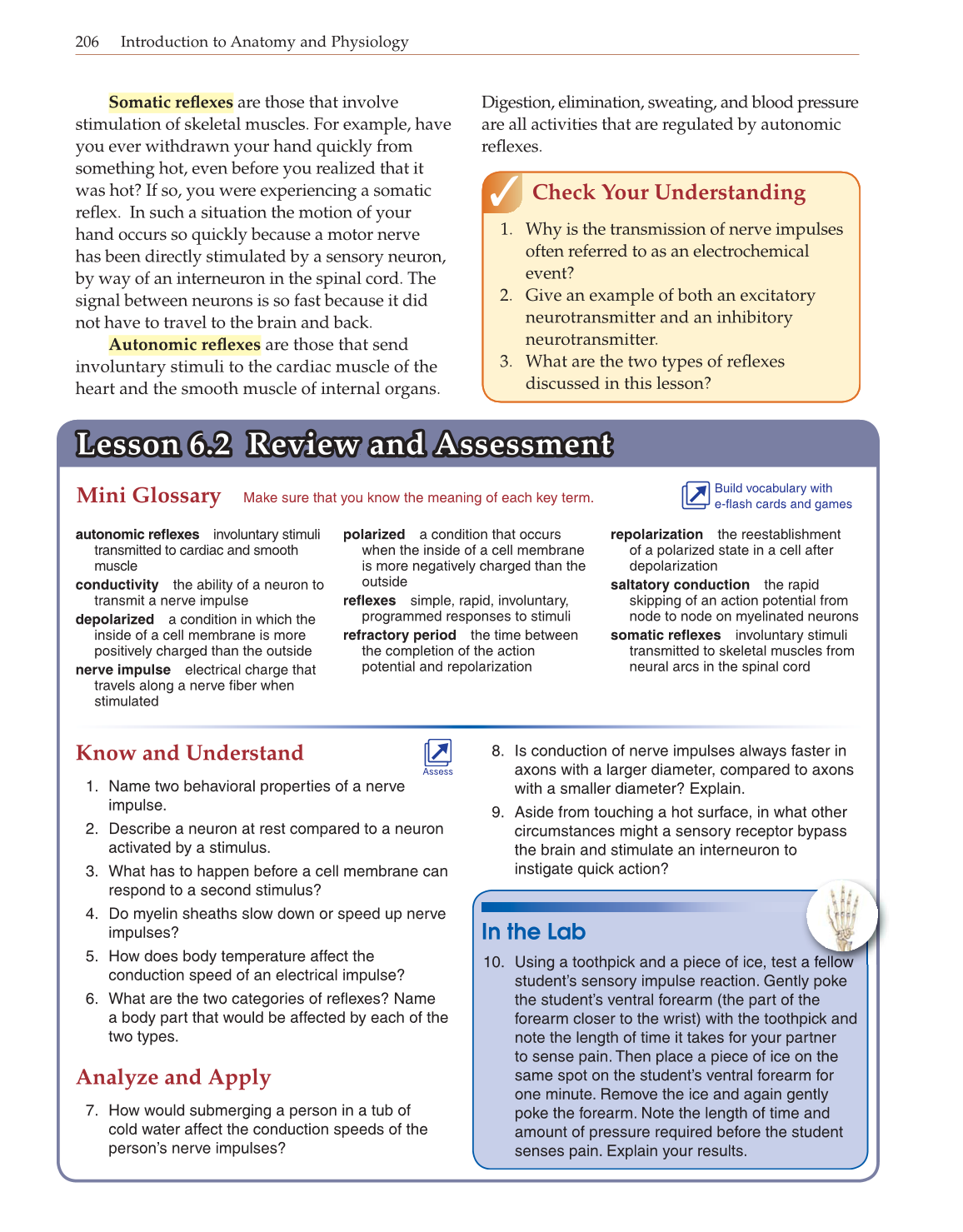206 Introduction to Anatomy and Physiology
Lesson 6.2 Review and AssessmentAssessment Lesson 6.2 Review and
Mini Glossary
Make sure that you know the meaning of each key term.
autonomic refl exes involuntary stimuli
transmitted to cardiac and smooth
muscle
conductivity the ability of a neuron to
transmit a nerve impulse
depolarized a condition in which the
inside of a cell membrane is more
positively charged than the outside
nerve impulse electrical charge that
travels along a nerve fi ber when
stimulated
polarized a condition that occurs
when the inside of a cell membrane
is more negatively charged than the
outside
refl exes simple, rapid, involuntary,
programmed responses to stimuli
refractory period the time between
the completion of the action
potential and repolarization
repolarization the reestablishment
of a polarized state in a cell after
depolarization
saltatory conduction the rapid
skipping of an action potential from
node to node on myelinated neurons
somatic refl exes involuntary stimuli
transmitted to skeletal muscles from
neural arcs in the spinal cord
Know and Understand
1. Name two behavioral properties of a nerve
impulse.
2. Describe a neuron at rest compared to a neuron
activated by a stimulus.
3. What has to happen before a cell membrane can
respond to a second stimulus?
4. Do myelin sheaths slow down or speed up nerve
impulses?
5. How does body temperature affect the
conduction speed of an electrical impulse?
6. What are the two categories of refl exes? Name
a body part that would be affected by each of the
two types.
Analyze and Apply
7. How would submerging a person in a tub of
cold water affect the conduction speeds of the
person’s nerve impulses?
Assess
Build vocabulary with
e-fl ash cards and games
8. Is conduction of nerve impulses always faster in
axons with a larger diameter, compared to axons
with a smaller diameter? Explain.
9. Aside from touching a hot surface, in what other
circumstances might a sensory receptor bypass
the brain and stimulate an interneuron to
instigate quick action?
10. Using a toothpick and a piece of ice, test a
student’s sensory impulse reaction. Gently poke
the student’s ventral forearm (the part of the
forearm closer to the wrist) with the toothpick and
note the length of time it takes for your partner
to sense pain. Then place a piece of ice on the
same spot on the student’s ventral forearm for
one minute. Remove the ice and again gently
poke the forearm. Note the length of time and
amount of pressure required before the student
senses pain. Explain your results.
In the Lab
a fellowfellow
Somatic refl exes are those that involve
stimulation of skeletal muscles. For example, have
you ever withdrawn your hand quickly from
something hot, even before you realized that it
was hot? If so, you were experiencing a somatic
refl ex. In such a situation the motion of your
hand occurs so quickly because a motor nerve
has been directly stimulated by a sensory neuron,
by way of an interneuron in the spinal cord. The
signal between neurons is so fast because it did
not have to travel to the brain and back.
Autonomic refl exes are those that send
involuntary stimuli to the cardiac muscle of the
heart and the smooth muscle of internal organs.
Digestion, elimination, sweating, and blood pressure
are all activities that are regulated by autonomic
refl exes.
1. Why is the transmission of nerve impulses
often referred to as an electrochemical
event?
2. Give an example of both an excitatory
neurotransmitter and an inhibitory
neurotransmitter.
3. What are the two types of refl exes
discussed in this lesson?
Check Your Understanding
